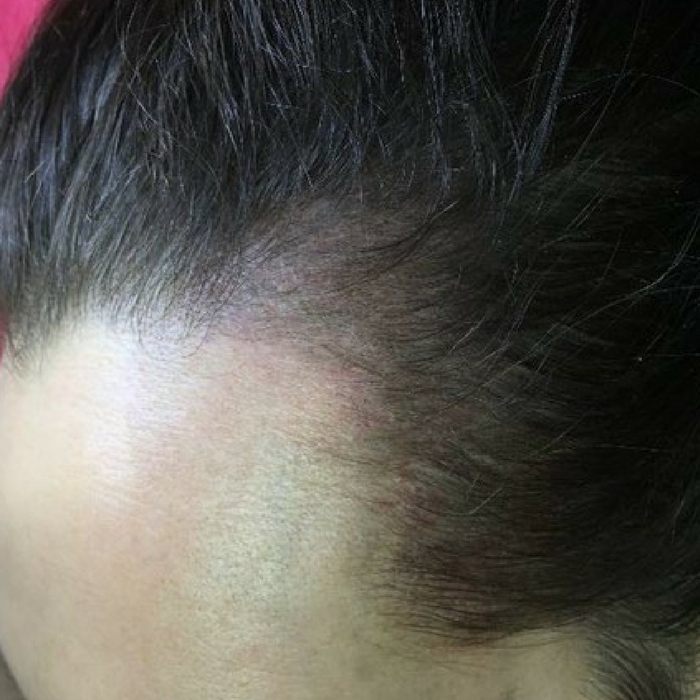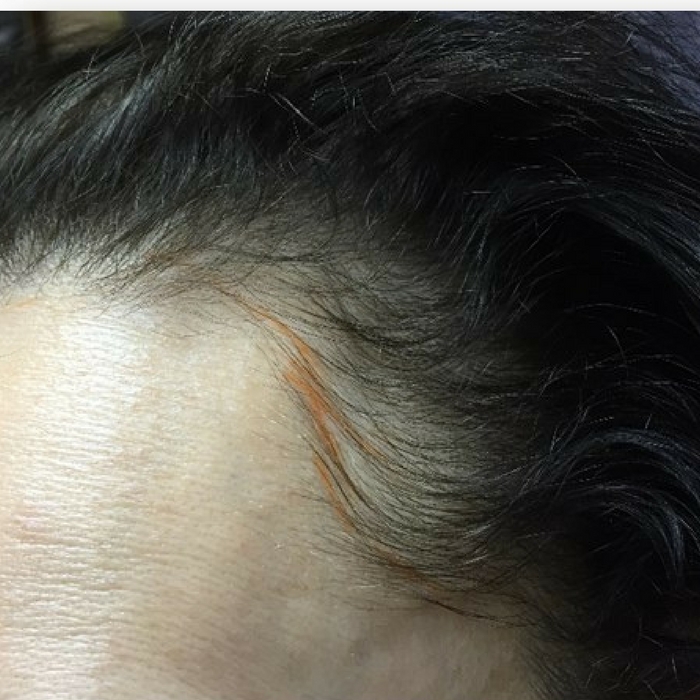The basics of trichopigmentation for the PM master: we comprehend new heights
Tricopigmentation for men and women

More and more clients with baldness problems turn to PM masters. And more and more often among them there are representatives of the fair sex. And our task is to make a high-quality procedure, "returning" their hair
Anna Zabolotnaya, Head of the International Academy of PM and Aesthetic Dermopigmentation "Biotek" (Russia), certified artist, international class master teacher in permanent make-up, aesthetic dermopigmentation and trichopigmentation, winner of the first Contour of the Century competition (2003), judge of permanent make-up championships in Russia and abroad, lecturer at the International University of PM (Milan, Italy) (Russia)
Alopecia is a disease that you can put up with, but, alas, not everyone can live with it fully. First of all, it depends on how we perceive ourselves. However, we should not discount those around us, whose opinion often means too much to us.
Let's first understand what kind of disease it is and why, according to statistics, up to 75% of the population suffer from it.
Alopecia: types and causes
Alopecia is the loss of hair on the head or trunk, leading to complete or partial baldness. Hair loss can occur for various reasons, based on which experts distinguish many types of alopecia. The most common types of this disease are androgenetic (androgenic), diffuse (it is also called symptomatic) and scarring alopecia.
Up to 95% of male and up to 90% of female alopecia are androgenetic or androgenic in nature. Its mechanism has not been fully explored, but it is known for sure that androgens are to blame for it - steroid hormones produced by the body of both sexes.
Androgenetic alopecia in men and women manifests itself in different ways. If in men hair loss is localized in the parietal and frontal zones, then in women it occurs mainly in the area of the central parting.
The cause of diffuse alopecia is often systemic failures of the body, so it is called symptomatic. It is characterized by uniform hair loss over the entire scalp and is more common in women. Although it is also observed in men.
As for cicatricial alopecia , the name speaks for itself: it occurs at the site of damage to the hairy skin and occurs with equal frequency in both men and women.
Having beautiful thick hair on your head is very important even for men, not to mention ladies, for whom thinning or loss of hair can be a real tragedy. And since the cause of alopecia, as a rule, is systemic failures of the body, the drug treatment of this disease today is ineffective and rarely passes without undesirable side effects. (For example, it has been proven that castration in men in all cases leads to a stop of baldness. But there is hardly a single man who is ready to take such measures to save his hair.)
Before and after the procedure. Photos provided by the author.
The only effective method of hair restoration is hair transplantation. But, alas, this method is not perfect. Firstly, it does not give a 100% guarantee that the transplanted hair will survive. Secondly, it cannot stop or even slow down the process of falling out. And thirdly, after surgery to restore the hairline, scars remain, which often require a separate operation to hide.
As usual, where medicine is powerless or ineffective, permanent makeup comes to the rescue, or rather, trichopigmentation , that is, the PM section, which is responsible for imitating or drawing hair where necessary.
Before and after the procedure.
Fundamentals of trichopigmentation
Tricopigmentation is a safe and effective solution not only for androgenetic and symptomatic alopecia, but also for hair loss on scars after transplantation and in general in case of any scar formation.
It must be admitted that the effectiveness of trichopigmentation also has its limits. For example, on a head completely devoid of hair, it is impractical to imitate them: even with a masterfully performed procedure, it will still be noticeable that this is a tattoo, which is tricopigmentation in its essence. Therefore, the optimal effect can be achieved when there are still hair residues around the area affected by alopecia.
Before and after the procedure.
Another important point: it must be borne in mind that the result of the procedure remains on the skin for a long time. Therefore, trichopigmentation in this area is carried out only in a situation where baldness does not progress for a long time.
To understand the principle of hair drawing technique, it is necessary to study the nature of the scalp. First you need to consider how straight and wavy hair grow. They can be collected in strands or break up into separate curls. The human head moves more actively than any other part of the body, causing the hair to change its position. The shape of the head is round, and the hair grows from the roots at an angle over its entire surface. The realism of the image of the hair is achieved by reproducing wavy lines of various lengths that repeat the shape of the skull or individual strands. Straight hair can either lie flat on the surface of the head or stick up.
In addition to the fact that the hair is bent in different directions, it curls outward and inward. Separate strands, depicted in lighter tones, seem to also bend towards the “spectator”. Darker tones give the impression that the curls are curving inwards. The more contrasting the tone, the more voluminous the hair looks.
It is very important, when using different tones when drawing, to change the density of dashed lines, the pressure and the type of needle.
By applying a different number of hatching layers, you can achieve an extremely smooth transition of tones. The transition between tones will become almost imperceptible if the length of all lines is different. At the same time, the hatching edges should be uneven so that the transition between tones is natural.
Before and after the procedure.
Features of the procedure
You need to start drawing hair from the roots. If you start from the ends of the hair, there is a risk of giving them a sharp, chopped look. Let the natural taper effect that comes at the end of a pencil stroke or further typing work work for you.
Hair can be both liquid and thick. Liquid must be drawn with thin lines - a unit. The thinner the line, the richer the texture of the hair will be. Drawing curly hair takes more time and patience than straight hair. Hair will not look curly if it is drawn only with wavy lines. For a realistic image, you need to pay special attention to each curl. Separate strands should be partially overlapped by others, thereby enhancing the impression of depth and volume.
It should be remembered that the hair on the head is a lot of individual curls, which consist of many individual strands. Therefore, you cannot paint over, shade, or fill with a solid color the area you are working on.
The art of trichopigmentation does not tolerate haste. The biggest enemy of a realistic image is impatience. Often it is impatient to complete the work, not even having time to really start it. If this is not followed, the hand begins to move in a hurry, and this is immediately reflected in the result.
Hair is soft and hard. To mimic the texture of soft hair, you can use a small bunch of several needles or a small flat bun. (Too large bunches of needles will give a very blurry line.) A flat needle will allow you to make soft, wide strokes that will give the impression that the hair is blended together.
If you'll be using a flat bun for most of the pattern, you'll still need to go over some areas in one piece to highlight and separate the strands. But, if you place the strokes very close together, it will be difficult to distinguish one line from the next.
In the case of simulating coarse hair, only needle No. 1 should be used, which is quite logical. This technique is completely opposite to the technique of drawing soft hair. But, as you know, the unit is the most traumatic needle. And the scalp is the thinnest on the human body.
If you under-salted your food, you can always fix it later, but if you over-salt it, there's nothing you can do about it. The same thing will happen if you press the needle too hard on the skin - there will definitely be dark, very difficult to correct spots. So when you draw hair, be careful with the pressure on the needle, especially when dealing with highlights on blondes and blonde brunettes.
The color is selected as natural as possible: for the natives of the middle lane, these are mostly gray-brown shades, often with an olive tint. Even if the client is a light blonde, the shade is chosen a little darker than his hair, to match the color of the roots. As in permanent eyebrow makeup, black is completely excluded, because as a result it gives an ugly and unnatural blue.
No special care after the procedure is required. Usually, the result of the procedure takes on its final form when the healing process is completed, that is, after a month. But, taking into account the individual characteristics of the skin, it is better not to expose the procedure area to undesirable physical, chemical and other influences - for example, exposure to sunlight - for two months.
And finally, despite the fact that, according to statistics, alopecia is more of a male disease, many clients who want to undergo a trichopigmentation procedure are women who are not afraid to experiment. We can only express our support to them. With proper execution, trichopigmentation always gives an impressive effect.
True, in order to obtain such a result, a specialist must have the highest qualifications and undergo special training. In addition, high-quality trichopigmentation is possible only on high-end equipment and using pigments designed exclusively for this procedure. Not to mention that a real master must have the skills of an artist, have a sense of style, symmetry and sufficient experience.
The material was first published in Permanent No. 2(10)/2018
Read also
- Oily skin and permanent makeup: acceptable techniques
- Complex permanent make-up: master's difficulties and client's fears
- 7 reasons, or Why lasers for PM removal break down?
- Work on oily skin: factors affecting the quality of permanent makeup
- Tattoo pigments in the permanent makeup procedure: consequences of use
- Infection safety for permanent makeup artists
- Areola repigmentation: aesthetics with permanent makeup
- Permanent lip makeup: correcting the shape
- Sterilization in the permanent makeup room: methods and means
- Arrow with shading in permanent makeup
- Tricopigmentation techniques
- Tricopigmentation
- Micropigmentation
- Permanent makeup

